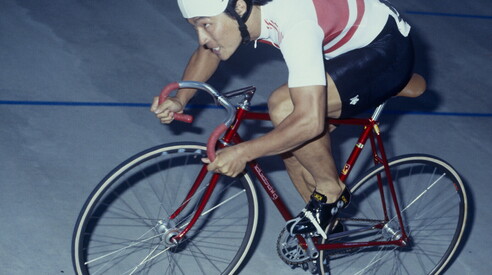The unbeatable and ruthless Nakano, the Japanese king of the track


Koichi Nakano (photo Getty Images)
the sports paper
The greatest rider in the history of Keirin and track cycling turns 70.
Ten consecutive world championship titles. No one like him, before or since, ever. Track, Speed, from 1977 to 1986: undefeated, unbeatable. Considered a "phenomenon," dubbed "the Emperor," compared to Hirohito, who reigned in Japan from 1926 to 1989. And on November 14th—the birthday of cycling champions, from Adorni to Hinault and Nibali— Koichi Nakano will turn 70.
Born in Kurume (spared from the atomic bombs due to bad weather conditions), son of an artist (his father Mitsuhito, a sprinter, retired at 50), compact physique (1.72 m for 85 m), raised in the Keirin (sprint race, up to eight riders, initially behind a motorbike), Nakano appeared in the world of cycling in 1976 . Giordano Turrini: “World Championships in Monteroni, Puglia. Up until that point, Japanese athletes had been rare. I faced Nakano in a heat. I didn't know him. He beat me. I came back through repechages. I met him again in the semifinals, but now I knew what he was like: strong, very strong, but inexperienced, and I won both events. Speed wasn't just about strength, but also about cunning and intuition, strategy and timing. A lot depended on the length of the track : on long ones, legs counted, on short ones, even the head. For me, the shorter the track, the more suited I was.” In the final for first place, Turrini was defeated by Australian Nicholson, while in the final for third place, Nakano was defeated by his compatriot Sugata.
In 1977, Nakano's absolute dominance began. No Italian would ever beat him again. Guido Bontempi: "1981 World Championships, Czechoslovakia, Brno, semifinal. I won silver in the Keirin. In the sprint semifinal, I faced Nakano. First run, I did well to close him out, but he didn't give up, he shouldered me, his knee hooked my handlebars, and I fell. I fractured my knee, was taken to the hospital, immobilized, returned to Italy, underwent surgery, and was put in a cage and wire for 60 days. He was disqualified, but only for the first run, then he won the second and third on his own and qualified for the final." The only one competing with him was Canadian Gordon Singleton. 1982 World Championships, England, Leicester, Saffron Lane open-air velodrome. The 1982 final featured the same protagonists as the 1981 final. But this time, the race was dramatic. Nakano, wearing a helmet, and Singleton, wearing a leather-striped helmet, are the new Keirin champions after a wild performance in which he first elbows and then flails and slaps, but he gets away with it. First heat, Singleton leads and Nakano follows, glued to his wheel. Singleton launches the sprint, Nakano rebounds and passes. On the short final straight, Nakano turns right, but Singleton is on the left. Nakano converges on Singleton, they touch and fly across the finish line, Nakano in front and Singleton behind. The judges disallow the race. A repeat of the first heat: Singleton still leads and Nakano still behind. This time, Nakano passes and concedes the advantage of the back position to Singleton, who surprises him by launching a sprint from afar and winning by a wide margin. Second heat: Nakano leads the way, Singleton—in a bandaged condition—following. Singleton launches a sprint, Nakano fights back on the outside, the Japanese rider flares his elbows, and Singleton falls to the ground, crawling and tearing himself to pieces. The judges found no irregularities. The third heat is formal: Singleton's right shoulder is immobilized, his collarbone is fractured. According to the rules, Nakano simply needs to get on his bike to win, and the crowd boos and howls. Having overtaken and distanced Maspes and Belgian Scherens, who holds seven titles, Nakano devotes himself exclusively to Keirin, which, thanks to betting, offers stratospheric wages and prizes. And Keirin is his specialty.
It's said that Nakano earned $100 million in his career: he lent his name to a video game, he was an ambassador for Japanese cycling, he rode the bike in the 2000 Sydney Olympic Keirin race won by Frenchman Rousseau, he met Bontempi again at a restaurant at a Japan Cup ("They introduced us," Bontempi recalls, "he remembered me, but there was no controversy. Speed and Keirin were races at the limit , even beyond"), he inspired Marco Ballestracci's novel "Nakano ." "The moment to attack," Ballestracci writes, "comes when you hear a koto note in the air." That note surprised and distracted Nakano in the replay of the first heat against Singleton, the one he would always wait for, listen to, and interpret in sprints. A sweet, captivating, auspicious, silent melody.
More on these topics:
ilmanifesto





